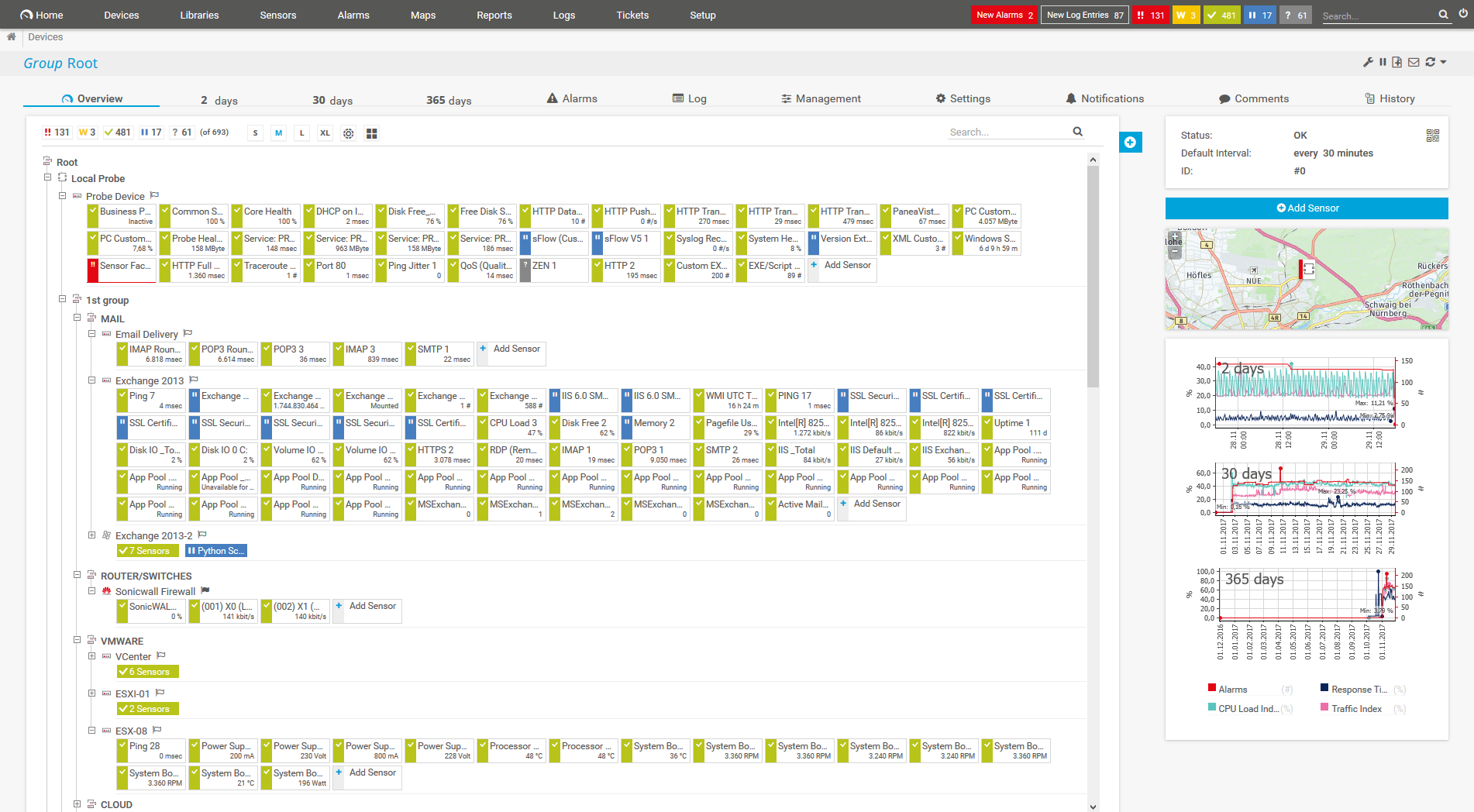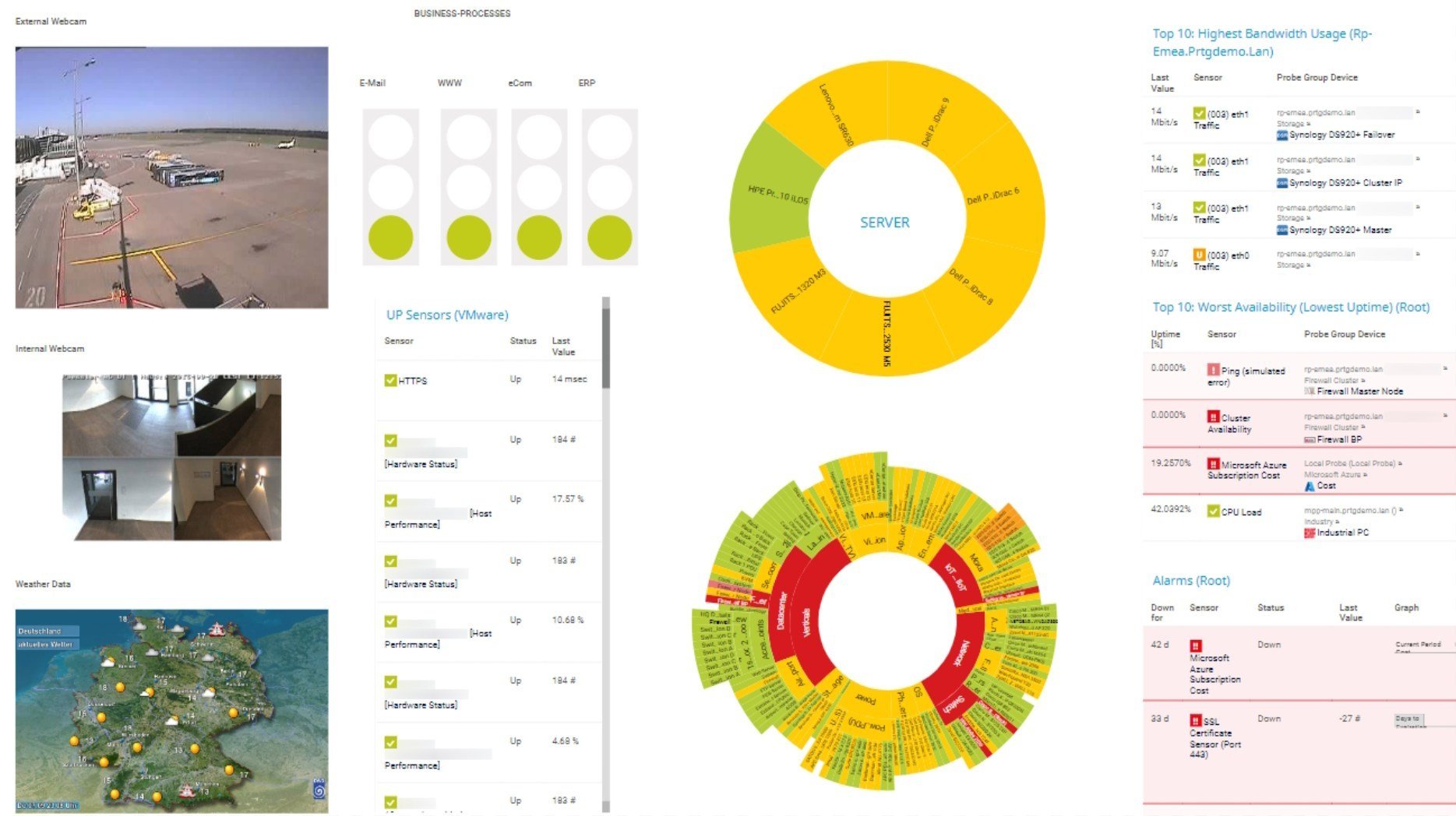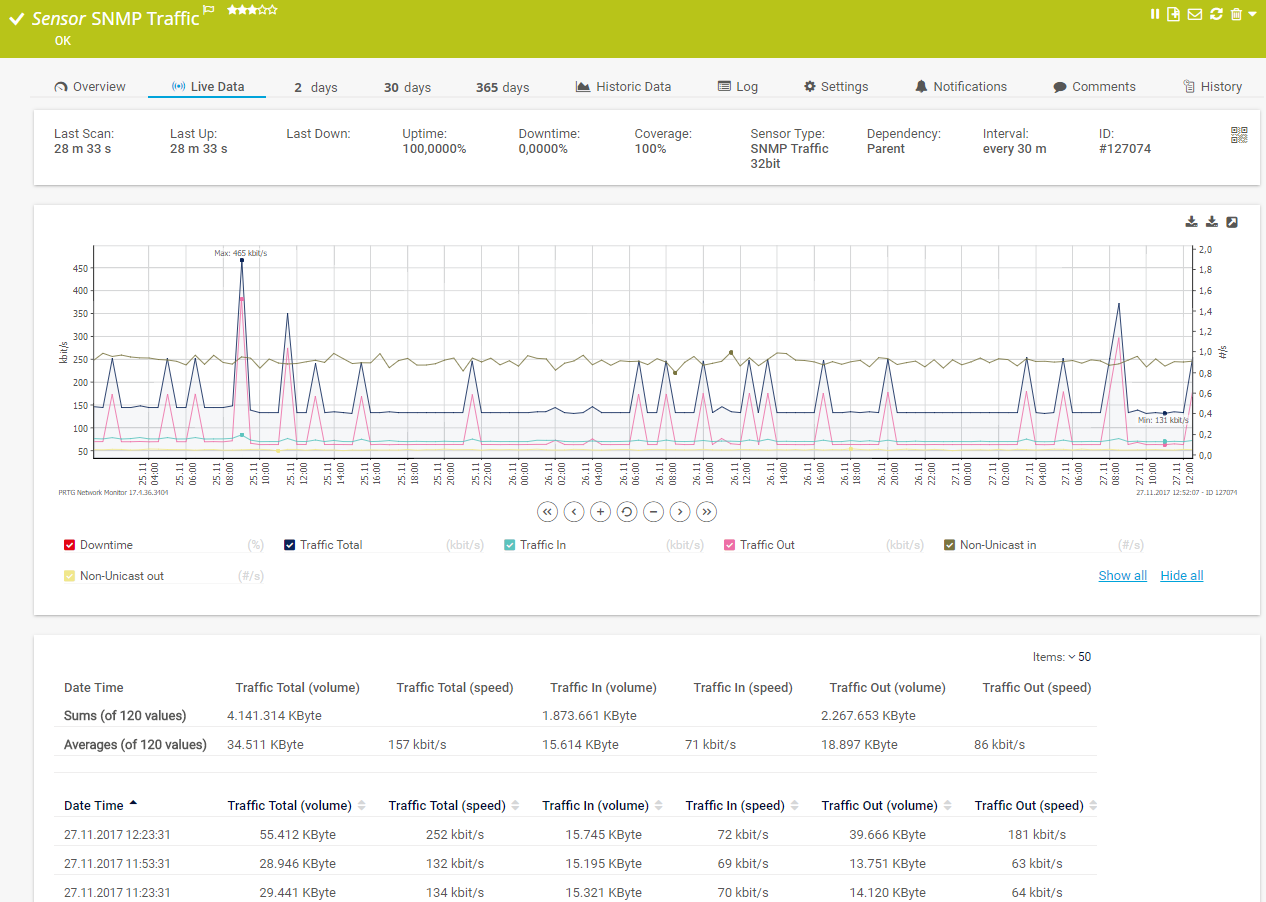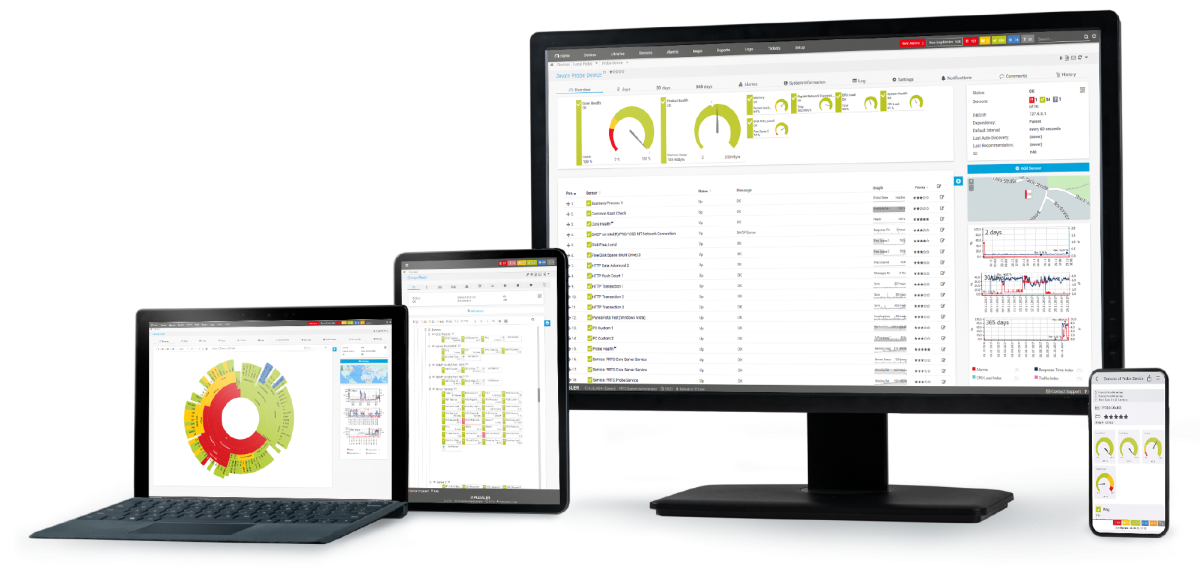Gli avvisi personalizzati e le visualizzazioni dei dati consentono di identificare e prevenire rapidamente lo spazio di archiviazione ridotto, i tempi di inattività, i colli di bottiglia della larghezza di banda e altri problemi di prestazioni.
Monitorare i dispositivi NAS QNAP con strumenti generici è come configurare un server manualmente. O, beh... mangiare la minestra con la forchetta.
Possibile. Ma perché affrontare tutti questi problemi, quando esistono strumenti dedicati che rendono il processo molto più semplice?
I sensori appositamente costruiti da Paessler PRTG sono progettati per funzionare perfettamente con qualsiasi dispositivo NAS prodotto da QNAP. Ciò significa che la configurazione è molto più rapida. E, cosa più importante, l'ambiente di rete QNAP è più completo, preciso e affidabile. Perché per svolgere bene un'attività specializzata è necessario uno strumento specializzato.
E quando diciamo semplice, intendiamo dire che PRTG si occuperà della maggior parte del lavoro. Il nostro Auto-discovery scansiona la rete per trovare i dispositivi QNAP all'avvio e li aggiunge all'ambiente di monitoraggio.
Tutto qui. Davvero. Una volta inseriti nel dashboard, PRTG inizia subito a monitorarli.
Risolvere i problemi di memoria insufficiente, i tempi di inattività, i colli di bottiglia che possono rallentare l'accesso ai dati e altri problemi di prestazioni è ottimo. Ma evitare che si verifichino è molto, molto meglio.
PRTG vi avvisa automaticamente via e-mail, SMS o notifica push (con le nostre app mobili per iOS e Andoid) quando importanti indicatori di salute rischiano di non funzionare, in modo che possiate intervenire e salvare la situazione.
Poiché i sistemi NAS QNAP spesso contengono più physical disk che a loro volta sono combinati con logical disk, il loro monitoraggio può diventare complesso. Non con PRTG.
Tenete d'occhio la quantità di spazio di archiviazione rimanente, assicuratevi che i backup funzionino correttamente e che la capacità di archiviazione sia distribuita in modo appropriato, il tutto da un unico punto centrale.
PRTG può monitorare anche dispositivi NAS di altri produttori, tra cui Buffalo TS, LenovoEMC e Synology. Anzi, già che ci siete, perché non tenere d'occhio l'intera rete?
Con oltre 250 sensori preconfigurati, PRTG rende questo processo rapido e semplice.
Diagnostica i problemi di rete monitorando continuamente le unità fisiche e logiche e la salute del sistema, oltre alle virtual machine (VM), ai dispositivi di controllo degli accessi, ai router Wi-Fi e a tutti gli altri componenti della rete. Mostra disponibilità, storage, traffico e altre metriche chiave in tempo reale. Visualizzate i dati di monitoraggio in grafici e dashboard chiari per identificare più facilmente i problemi. Ottenete la Panoramica necessaria per la risoluzione di colli di bottiglia, prestazioni insufficienti e altri problemi di rete legati alla NAS.

Albero dei dispositivi dell'intera configurazione di monitoraggio

Dashboard PRTG personalizzato per tenere sotto controllo l'intera infrastruttura IT

Grafico dei dati di traffico in tempo reale in PRTG
PRTG è dotato di oltre 250 tipi di sensori nativi per il monitoraggio dell'intero ambiente on-premises, cloud e cloud ibrido. Dai un'occhiata ad alcuni esempi qui sotto!
Consulta il manuale di PRTG per un elenco di tutti i tipi di sensore disponibili.
Notifiche in tempo reale significano una risoluzione più rapida dei problemi, in modo da poter intervenire prima che si verifichino problemi più gravi.
PRTG si configura in pochi minuti e può essere utilizzato su un'ampia gamma di dispositivi mobili.

“Eccellente strumento per un monitoraggio dettagliato. Gli avvisi e le notifiche funzionano perfettamente. L'aggiunta dei dispositivi è intuitiva e la configurazione iniziale del server è molto semplice. ...acquistatelo tranquillamente se desiderate monitorare un vasto panorama di rete.”
Grazie alla collaborazione con fornitori IT innovativi, Paessler libera sinergie per creare nuovi e ulteriori vantaggi per i suoi clienti.
L'IT che funziona costituisce una base critica per il successo di un'azienda. La disponibilità e la sicurezza devono essere definite per il rispettivo scopo e monitorate attentamente, sia da parte dell'OT che dell'IT.
L'integrazione dei risultati del monitoraggio di PRTG nelle mappe di NetBrain costituisce la base per l'automazione della rete.
Con ScriptRunner Paessler integra una potente piattaforma di automazione degli eventi in PRTG Network Monitor.
Gli avvisi personalizzati e le visualizzazioni dei dati consentono di identificare e prevenire rapidamente lo spazio di archiviazione ridotto, i tempi di inattività, i colli di bottiglia della larghezza di banda e altri problemi di prestazioni.
Software di monitoraggio della rete – Versione 25.3.110.1313 (August 27, 2025)
Disponibile il download della versione per Windows e della versione cloud-based PRTG Hosted Monitor
Inglese, tedesco, spagnolo, francese, portoghese, olandese, russo, giapponese e cinese semplificato
Dispositivi di rete, larghezza di banda, server, applicazioni, ambienti virtuali, sistemi remoti, IoT e molto altro
Scegli l'abbonamento a PRTG Network Monitor più adatto a te
QNAP è un'azienda di Taiwan e sta per "Quality Network Appliance Provider". QNAP Systems, Inc. offre soluzioni di rete per la condivisione e la virtualizzazione dei file ed è anche un noto produttore di dispositivi NAS (Network Attached Storage).
Monitoraggio QNAP non è altro che il monitoraggio dei sistemi NAS del produttore QNAP. IT consente, tra l'altro, di monitorare:
Un software di monitoraggio QNAP come PRTG consente di tenere costantemente sotto controllo tutti questi valori e parametri. In questo modo, vi assicurerete che i dati siano archiviati in modo sicuro e facilmente accessibili in ogni momento.
PRTG è uno strumento proprietario di monitoraggio e gestione della rete che monitora e analizza qualsiasi dispositivo QNAP collegato alla LAN, alla WAN o alla VPN. Disponibile per sistemi basati su Windows e Linux o come soluzione cloud-hosted, aiuta a individuare problemi di archiviazione, memoria, traffico, velocità e altro, in modo da prevenire i colli di bottiglia e garantire la sicurezza dei dati critici dell'organizzazione.
I sensori di PRTG monitorano i dispositivi QNAP tramite SNMP. Ogni sensore tiene traccia di un parametro specifico. Scegliete le soglie di Warning e di errore che preferite e riceverete una notifica via SMS, e-mail o in-app se le prestazioni rischiano di scendere al di sotto di tali soglie.
Prima di tutto, assicuratevi di soddisfare i requisiti di sistema e che SNMP sia abilitato sia sulla rete che sui dispositivi NAS. In QNAP, l'interruttore "Abilita SNMP" si trova nella homepage del pannello di controllo. In Windows, si trova nelle impostazioni di sistema. Una volta fatto, fare doppio clic sul file .exe. PRTG rileverà automaticamente tutti i dispositivi QNAP abilitati a SNMP presenti sulla rete e li aggiungerà all'ambiente di monitoraggio.
In PRTG, i “sensori” sono gli elementi base del monitoraggio. Un sensore monitora solitamente un valore misurato nella tua rete (ad esempio, il traffico di una porta switch, il carico della CPU di un server o lo spazio libero di un’unità disco). In media, occorrono circa 5-10 sensori per ogni dispositivo o un sensore per ogni porta switch.
Paessler ha condotto prove in oltre 600 dipartimenti IT in tutto il mondo per mettere a punto il suo software di monitoraggio di rete più vicino alle esigenze dei sysadmin. Il risultato è che più del 95% degli intervistati consiglierebbe PRTG – o lo ha già fatto.
Paessler PRTG è utilizzato da aziende di tutte le dimensioni. Gli amministratori di sistema adorano PRTG perché rende il loro lavoro molto più semplice.
Ampiezza di banda, server, ambienti virtuali, siti Web, servizi VoIP - PRTG tiene d'occhio la tua intera rete.
Tutti hanno esigenze di monitoraggio diverse. Ecco perché ti lasciamo provare PRTG gratuitamente. Inizia oggi stesso la tua prova.